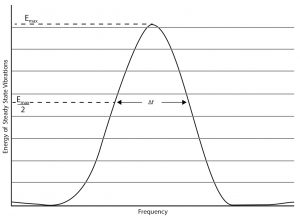Q Factor

A dimensionless parameter that describes how under-damped an oscillator or resonator is. A higher quality (Q) indicates a narrow resonance peak and a lower rate of energy loss relative to the stored energy of the resonator, so the oscillations die out more slowly. This implies that the system has a low value of damping present. Resonant systems that are excited sinusoidally having higher Q factors will resonate with greater amplitudes at the resonant frequency, but over a smaller range of frequencies. In machinery and piping components, lower Q values are preferred. Lower Qs typically mean lower vibration levels around resonance frequencies, or that a higher amount of damping is present.
The equation for quality factor (Q):
![]()
where fr is the resonance frequency and Δf is the difference between the upper and lower half power points of the peak.
Typical Qs for resonating systems encountered in machinery:
Centrifugal Rotors:
< 2.5 low
> 2.5 to 5 typical
> 5 high
Acoustic: 40+ typical
Piping Resonance: 20+ typical
Also known as Quality Factor.
